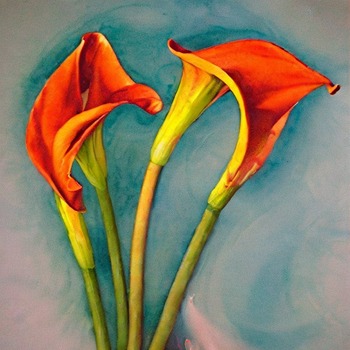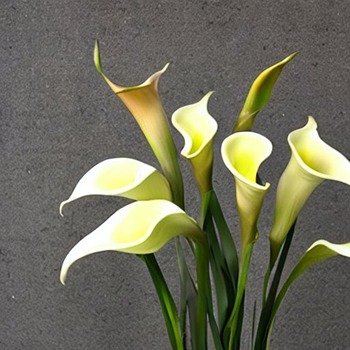Beautiful floral plant endemic to Southern Africa is Zantedeschia, sometimes known as Calla Lily. It has gained popularity for gardens and homes all over the globe because to its lovely chalice-shaped blooms and thick leaves. The lifespan of Zantedeschia is one subject that often comes up among plant aficionados. How long is the life span of this lovely plant? In this article, we will look into Zantedeschia’s lifespan and examine the variables that affect it.
The Lifespan of Zantedeschia
Since calla lilies are perennials, they have a lifespan of more than a year. However, a calla lily plant’s actual lifespan might vary based on a number of variables, including environment, maintenance, and variety. A well-kept calla lily may often grow and produce lovely blooms for several years given the correct circumstances.
Factors affecting life expectancy
Zantedeschia grows best in well-draining soil with plenty of sunshine and frequent watering. The lifespan of the plant depends on providing adequate growth conditions. A potted Zantedeschia may last for a few weeks to a few months with the proper care.
In order to expand your business, you need to know how to use the internet. With the right care, the plant can last the whole year in these areas. Zantedeschia is often treated as an annual or brought within during the winter in colder locations where it may not survive outside when temperatures dip below freezing.
The lifespan of Zantedeschia may be greatly increased with the right care and upkeep. Regular fertilization using a feed appropriate for indoor plants may benefit the plant’s general health and blooming duration. Ample watering and the removal of any dead or rotting leaves may also help to avoid infections and lengthen the life of plants.
Zantedeschia may be split and propagated in order to revive the plant and promote fresh growth. It is possible to improve nutrient absorption and increase plant lifespan by dividing the bulbs every few years.
Table of Contents
Lifespan Differences
The particular species and cultivars of Zantedeschia may have a different lifespan. There are eighteen different kinds of zantedeschia in the world, and each one has its own distinct qualities and lifespan. For instance, Zantedeschia aethiopica is a rhizomatous perennial plant with a lifespan that is longer than that of other species. It may grow up to 1.2 meters tall.
Increasing Lifespan

Here are some suggestions to increase your Zantedeschia’s lifespan if you want to enjoy it for as long as possible:
- A well-draining soil environment and enough sunshine are essential components of a suitable growing environment for your Zantedeschia. It’s important to remember that you can’t always get what you want.
- Regular Maintenance: To stop the spread of illnesses, remove any dead or rotting leaves right away. Keep pests away from the plant and keep it clean.
- Fertilization: Follow the label’s directions when using a fertilizer for houseplants. Regular feeding may lengthen the blooming season and encourage healthy development.
- Division: To promote new development and avoid crowding, think about splitting your Zantedeschia bulbs every few years. The plant’s lifespan may be increased by using this technique.
Is Zantedeschia an Annual or Perennial Plant?

Zantedeschia aethiopica, also known as Calla Lily, is a clump-forming herbaceous or semi-evergreen perennial. With its spectacular, enormous, pure white, trumpet-shaped blooms (spathes), which are accompanied by a golden finger-like spadix, it exudes a commanding stature. These gorgeous blossoms stand out against the background of long-stalked, arrowhead-shaped, dark glossy green leaves, producing a visual extravaganza in any garden.
The capacity to re-grow and re-establish yourself in a new location is a key part of the process. It’s crucial to remember that they do need some extra maintenance to maintain their durability and continual blossoming. You may continue to appreciate the beauty of these blooms for years to come by providing the proper growth conditions and making an additional effort.
Calla lilies grow as perennial perennials and bloom continuously all year long in zones 8–10, which have warmer conditions. For Calla lilies to grow naturally without any disturbance, these areas provide the perfect climate. To preserve the plants throughout the cold season, additional measures are needed in colder regions where winter frosts are a risk.
Calla lily perennial cultivars normally blossom in the spring, while annual versions often bloom in the summer. Gardeners who want to have a continuous display of Calla lilies throughout the year have more variety and possibilities because to this differentiation in blooming seasons. Additionally, a variety of flower hues are often available among the perennial types, providing for a colorful and dynamic garden palette.
It’s important to note that Calla lilies undergo a seasonal period of dormancy. The plants go through a period of dormancy once a year, usually after the flowering season. The plant’s energy is focused on creating subterranean rhizomes, which act as storage organs, during this period, which might result in some leaves dying back. This time of dormancy is an essential component of the plant’s life cycle and helps it survive and flourish as a perennial.
Southern Africa is home to Zantedeschia aethiopica, which may be found there growing in a variety of environments. It maintains its evergreen status in areas with sufficient temperatures and precipitation. In contrast, it becomes deciduous in drier regions at times of drought or a lack of water. This adaptable quality emphasizes the adaptability and toughness of this extraordinary plant even further.
How hard is it to keep a calla lily alive?

Calla lilies (Zantedeschia) may appear fragile, but with the appropriate information and care, they are very simple to take care of. These pointers will help you maintain healthy calla lilies whether you’re a novice or a seasoned gardener. Here are the most important tips to keep a calla lily alive:
1. Make sure the environment is right
Calla lilies do best in warm, wet places, so it’s important to make a space that’s similar to their natural home. These flowers do best in an open spot with bright light coming from the side. If you’re growing calla lilies inside, put them near a window or glass door where they can get 4 to 6 hours of sunshine every day. But be careful not to put them in direct, strong sunlight, which can burn the leaves.
2. Water and Wetness
Calla lilies need a steady supply of water to stay healthy. Keep the dirt moist, but not so wet that it won’t drain. Check the earth’s moisture level often during the growing season by sticking your finger about an inch into the dirt. If it feels dry, the plant needs water. But be careful not to water too much, because too much water can cause root rot.
3. Temperature and air moisture
Calla lilies need to stay at the right temperature and humidity levels. During the growing season, these plants do best when the temperature is between 65 and 75 °F (18 and 24 °C). Keep them away from cold air and temperatures below 50 degrees Fahrenheit, which can make the plants go to sleep. If you live in a place with colder winters, you might want to grow calla lilies in pots that you can bring inside during the dormant time.
4. Fertilization
Fertilizing calla lilies now and then helps them grow and bloom well. Choose a low-nitrogen fertilizer and use it as the maker tells you to. It’s important not to over-fertilize, because that can cause too much growth of leaves and not enough flowers. For a plant’s general health, it’s best to use a balanced fertilizer with similar amounts of nitrogen, phosphorus, and potassium.
5. Going to sleep and winter care
Calla lilies go to sleep on their own, usually between the end of summer and the beginning of fall. During this time, the plant might lose its leaves. To get your calla lily ready for its winter rest, gradually cut back on watering and let the soil dry out a bit. Once the leaves have died, you can cut them back so they are about 2 inches above the dirt. Store the rhizomes for two to three months in a cool, dark place with a temperature between 40 and 50 degrees Fahrenheit.
6. Bugs and sickness
Calla lilies are usually hardy plants, but sometimes pests and diseases can hurt them. Aphids, spider mites, and snails are common pests that can hurt calla lilies. Check your plants often for signs of bugs and take the right steps, like using organic poisons or picking off the pests by hand. Also, make sure there is good air flow around the plants to stop fungal diseases from growing.
7. Propagation
Calla lilies can grow from seeds or by dividing them. The most popular way is to divide the plants, which is best done in early spring when the plants are dormant. Separate the rhizomes carefully and put them in dirt that drains well, making sure each piece has at least one healthy shoot. After planting, give it a lot of water and continue to care for it regularly to help it grow.
Can You Leave Calla Lilies in the Ground All Year?

Yes, In Some hardy zones you can leave calla lilies in the ground for the whole year.
Calla lily bulbs over the winter
There are a few things you can do to make sure your calla lilies live through the winter. One choice is to dig up the calla plants and bring them inside for the winter. Calla lily bulbs do best in warm areas. If you live in a colder area, you can use this way to protect the bulbs from the harsh winter weather.
First, carefully dig up the calla root so that you don’t lose any of its important nutrients. The calla lily needs these nutrients to make it through the winter. Once the bulb is out of the ground, gently brush off any dirt that is still on it. Be careful not to hurt the roots as you do this. Also, cut away any dead leaves, keeping only the healthy parts of the plant.
Calla in storage Lily Flowers
After cleaning the bulbs, it’s important to put them away in the right way for the winter. Find a good place to store it, like a cool, dry place with a temperature between 45 and 55°F (7 and 13°C). You can store the bulbs in a jar with peat moss, vermiculite, or dry sand. Make sure the bulbs don’t touch each other when you put them in the jar. This will help stop the growth of any diseases or rot that might happen.
During the winter, check on the bulbs you kept and take out any that are rotting or damaged. By keeping an eye on their health, you can deal with any problems right away and make sure the bulbs stay in good shape.
Replanting Calla Lilies in the Spring
When there is no longer a chance of frost and the soil has warmed up to at least 65°F (18°C), you can replant your calla lilies in your yard. Choose a spot that gets full or partial sunlight to give the plants the light they need to grow. Loosen the dirt and add organic matter to help it drain better and grow more plants.
Dig a hole big enough to hold the calla lily bulb and make sure it is put about 4 to 6 inches (10 to 15 cm) deep. Put the bulb in the hole so that the point where it will grow is facing up, and then cover it with soil. Firm up the earth around the bulb to keep it from moving. Water the recently planted bulbs completely, giving them enough water to help them grow.
How Long Calla Lily Blooms Last
Not only do calla lilies look great in the yard, but they also make great cut flowers. With proper care, calla lily flowers can last up to two weeks in a vase. If you want them to last as long as possible, it’s best to carefully pull the flower stems instead of cutting them. Leaving the flowers on the trees can make them last about a month longer.
Start Calla lilies indoors
Gardeners who want to get a jump on the growing season can start calla lilies indoors. Plant the rhizomes inside about a month before your area’s last expected frost date. With this method, the calla lilies can grow roots before being moved to the yard when the weather gets warmer.
Conclusion
A beautiful plant called Zantedeschia, or Calla Lily, is recognized for its graceful blossoms and luxuriant leaves. Zantedeschia is a perennial plant, therefore its precise lifespan varies depending on a number of variables. Your Zantedeschia will flourish and continue to enhance your garden or home for many years if you give it the right growth conditions, good maintenance, and sometimes division. Enjoy Zantedeschia’s amazing beauty and incredible lifespan.
Related Posts:
Are Calla Lilies Perennial or Annuals?
Calla Lilies In Pots – Do They Grow Well(Care, How to)
Do Calla Lilies grow well in Florida? All You Need to Know
Deadhead Calla Lily – How and When to Cut Back
Calla Lily – Cuttings, Propagation, Spreads, Rhizomes(Care)
Calla Lily Varieties A Guide to Different Colors and Shapes
Calla Lily Leaves but No Flowers
What Is the Meaning Behind White Calla Lily Flowers
Calla Lily Leaves Turning Yellow
Top 18 Flowers That Represent New Beginnings
Reference:
